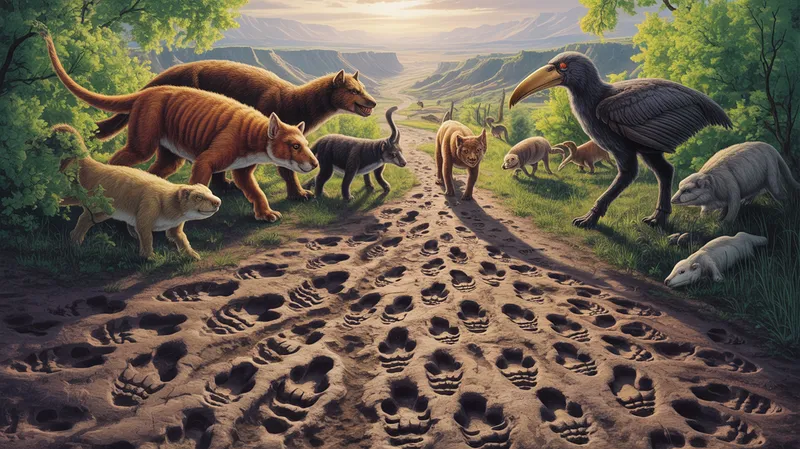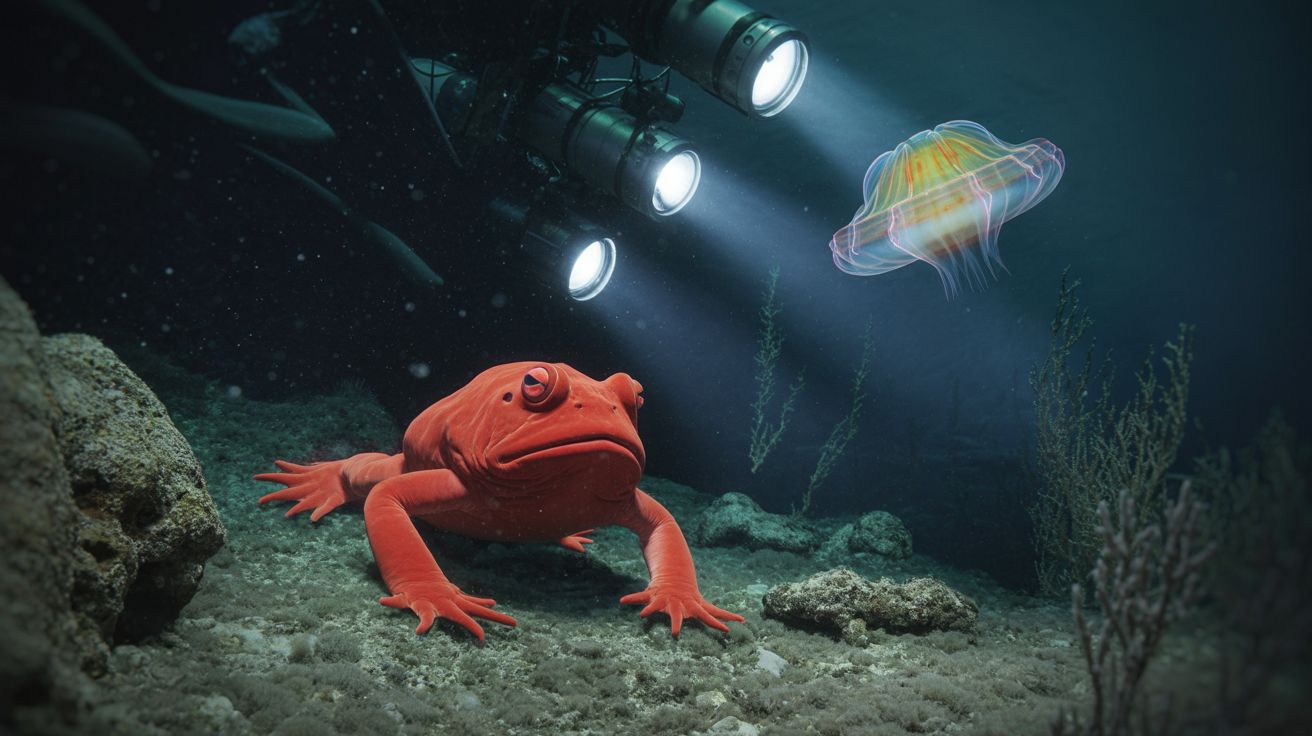Ancient Footprints, New Insights: What Prehistoric Tracks Reveal About Animal Behavior
Imagine walking across a landscape where, millions of years before, saber-toothed cats, giant birds, and early mammals crossed muddy ground, leaving behind a secret record of their lives. Today, fossilized footprints—also known as trace fossils or ichnites—are offering scientists an unparalleled window into not only what prehistoric animals looked like, but how they moved, socialized, hunted, and survived in ancient ecosystems. Recent discoveries, especially from sites like Oregon’s John Day Fossil Beds, are rewriting the story of animal behavior and evolution.
The Power of Tracks: A Record Written in Stone
Unlike bones or teeth, footprints capture a moment in time—an action, a decision, even a struggle for survival. These tracks preserve behaviors that skeletal fossils alone cannot reveal, such as migration, hunting strategies, parental care, and social interactions. According to a 2025 report from the National Park Service, the newly unearthed tracks at Oregon’s John Day Fossil Beds preserve evidence of animals moving in groups, changing pace, and even interacting with one another—offering a dynamic snapshot of prehistoric life.
What Do Fossil Footprints Tell Us?
- Gait and Speed: Track spacing and depth can reveal whether an animal was walking, running, or suddenly accelerating. For example, recent discoveries in China show dinosaur trackways where the animal changed its speed—possibly to pursue prey or avoid danger (Earth.com, 2025).
- Social Behavior: Parallel trackways suggest herding or pack movement, much like today’s Yellow Mongoose, which often moves in social groups across grasslands.
- Parenting and Care: Some fossil footprints reveal the presence of juveniles alongside adults, suggesting parental care—an ancient behavior mirrored in modern species like the Western Lowland Gorilla.
- Interactions with Environment: The presence of multiple species’ tracks in the same area reveals predator-prey dynamics and niche partitioning, echoing the complex ecological webs found today.
Oregon's John Day Fossil Beds: A Treasure Trove of Prehistoric Behavior
In April 2025, researchers announced the discovery of remarkably well-preserved fossilized animal footprints at the John Day Fossil Beds National Monument in Oregon (CNN, 2025). These tracks, dating back nearly 50 million years, include those of ancient birds, lizards, and a saber-toothed cat—making them the first of their kind found at this site (Statesman Journal, 2025).
“These fossilized footprints are like opening a time capsule, giving us direct evidence of how animals interacted with their environment and each other,” says Dr. Anna Behrensmeyer, a noted paleontologist.
3D modeling of the tracks revealed surprising details, such as:
- Evidence of group travel, suggesting early social behavior.
- Tracks from different species crisscrossing, indicating a rich, biodiverse ancient habitat.
- Signs of sudden speed changes, hinting at potential predator-prey chases or environmental stressors.
These discoveries mirror behaviors seen in modern animals. For example, the Eurasian Eagle-owl often leaves distinct talon marks in soft ground when it lands or hunts, much like its prehistoric bird relatives whose tracks are now fossilized in stone.
From Dinosaurs to Saber-toothed Cats: A Global Trail of Discovery
Oregon is not alone in yielding these behavioral treasures. Recent excavations in China uncovered over 80 dinosaur footprints, revealing a meat-eating dinosaur’s varying pace—walking, then sprinting, then slowing again (Earth.com, 2025). Meanwhile, a massive site in Alaska has exposed a landscape covered in dinosaur tracks, fossilized plants, and tree stumps, offering clues about prehistoric climate adaptation and migration routes (BBC Wildlife Magazine, 2024).
Connecting Continents and Species
In a remarkable 2024 discovery, over 260 Early Cretaceous dinosaur footprints were found in both Brazil and Cameroon, providing evidence of an ancient land connection between South America and Africa (LatinAmerican Post, 2024). These findings underline how animal movement and migration shaped the evolution of continents and species—much like the migratory journeys of seabirds such as the Blue-footed Booby, which navigates vast ocean distances today.
Stories of Survival: Interpreting Prehistoric Tracks
What can a single trackway reveal? Consider the 10,000-year-old footprints found in White Sands, New Mexico. These tracks document a human—possibly a mother—carrying a child across a muddy landscape, returning hours later without the child (National Geographic, 2020). Along the way, the traveler’s footprints are accompanied by those of a giant sloth and mammoth, suggesting a complex web of coexistence and risk.
Similar stories are emerging from Oregon, where ancient bird and lizard tracks intertwine with those of saber-toothed cats, painting a picture of daily life, danger, and survival in a prehistoric ecosystem. Much like the Satin Bowerbird today, which leaves behind evidence of its courtship rituals through carefully arranged bowers and scattered objects, prehistoric animals left behavioral footprints that tell us about their lives in surprising detail.
Modern Parallels: What Today’s Animals Teach Us About the Past
By comparing fossilized tracks with those made by modern species, scientists can draw powerful parallels:
- Burrowing and Foraging: Tracks of small mammals in ancient beds resemble those left by today’s Yellow Mongoose, which forages in groups and creates intricate burrow systems.
- Bird Behavior: Fossilized avian tracks can be compared to those of modern species like the Noisy Miner, which are known for their flocking and territorial habits.
- Predation and Escape: Trackways showing sudden changes in direction or speed suggest moments of pursuit or evasion—behaviors mirrored in predator-prey dynamics today.
These comparisons enrich our understanding of how ancient animals responded to their environments—insights that help conservationists predict how current species might adapt to climate change and habitat loss.
Conservation Lessons from Ancient Trackways
Studying ancient footprints is not just about satisfying curiosity; it has real implications for modern conservation. By understanding how prehistoric animals adapted to changing climates, migrated across continents, and formed complex social structures, we can gain insights into the resilience—and vulnerability—of today’s wildlife. For example, modern climate change may force animals to alter their migratory routes or social behaviors, as their ancestors once did in response to ancient environmental shifts.
Conservationists can use this knowledge to design wildlife corridors, protect critical habitats, and anticipate the effects of environmental stressors. As new discoveries continue to emerge from fossil beds around the world, they remind us of the interconnectedness of all life—past and present.
How You Can Get Involved: Preserving the Record of Life
- Visit Fossil Sites: National parks like John Day Fossil Beds offer guided tours and educational programs that connect visitors to Earth’s deep history.
- Support Conservation Organizations: Many groups work to protect habitats that preserve both living species and the ancient record beneath our feet.
- Participate in Citizen Science: Amateur fossil hunters often make crucial discoveries. Always report finds to professionals to help preserve context and scientific value.
“Every track is a story, every fossil bed a chapter in the epic of life on Earth. Preserving these stories is a responsibility we all share.”
Conclusion: Ancient Tracks, Modern Wonders
From the muddy banks of prehistoric Oregon to the windswept fossil fields of Alaska and the ancient savannas once linking continents, animal footprints have preserved the drama, diversity, and adaptability of life across eons. As scientists uncover new tracks and decode their meaning, we are reminded that every living animal—whether a Western Lowland Gorilla, a Blue-footed Booby, or a Satin Bowerbird—carries forward the legacy of those who walked before. The record of life is written not just in bones, but in the footprints that mark the journey of evolution itself.




